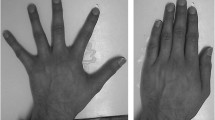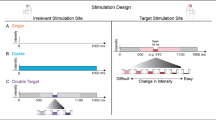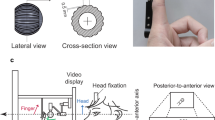Abstract
Long-range tactile masking has been reported between mirror symmetric body locations. This suggests a general principle of contralateral inhibition between corresponding points on each side of the body that may serve to enhance distinguishing touches on the two halves of the body. Do such effects occur before or after posture is added to the body schema? Here, we address this question by exploring the effect of arm position on long-range tactile masking. The influence of arm position was investigated using different positions of both the test and masking arms. Tactile sensitivity was measured on one forearm, while vibrotactile-masking stimulation was applied to the opposite arm or to a control site on the shoulder. No difference was found in sensitivity when test arm position was varied. Physical contact between the arms significantly increased the effectiveness of a masking stimulus applied to the other arm. Long-range masking between the arms was strongest when the arms were held parallel to each other and was abolished if the position of either the test arm or the masking arm was moved from this position. Modulation of the effectiveness of masking by the position of both the test and masking arms suggests that these effects occur after posture information is added to the body’s representation in the brain.

Similar content being viewed by others
References
Azañón E, Soto-Faraco S (2008) Changing reference frames during the encoding of tactile events. Curr Biol 18:1044–1049
Azañón E, Camacho K, Soto-Faraco S (2010a) Tactile remapping beyond space. Eur J Neurosci 31:1858–1867
Azañón E, Longo MR, Soto-Faraco S, Haggard P (2010b) The posterior parietal cortex remaps touch into external space. Curr Biol 20:1304–1309
Braun C, Hess H, Burkhardt M et al (2005) The right hand knows what the left hand is feeling. Exp Brain Res 162:366–373
Corradi-Dell’Acqua C, Tomasino B, Fink GR (2009) What is the position of an arm relative to the body? Neural correlates of body schema and body structural description. J Neurosci 29:4162–4171
Costantini M, Haggard P (2007) The rubber hand illusion: sensitivity and reference frame for body ownership. Conscious Cogn 16:229–240
Craig JC (2003) The effect of hand position and pattern motion on temporal order judgments. Percept Psychophys 65:779–788
Craig JC, Belser AN (2006) The crossed-hands deficit in tactile temporal-order judgments: the effect of training. Perception 35:1561–1572
D’Amour S, Harris LR (2014a) Contralateral tactile masking between forearms. Exp Brain Res 232:821–826
D’Amour S, Harris LR (2014b) Vibrotactile masking through the body. Exp Brain Res 232:2859–2863
Fabri M, Polonara G, Mascioli G et al (2006) Contribution of the corpus callosum to bilateral representation of the trunk midline in the human brain: an fMRI study of callosotomized patients. Eur J Neurosci 23:3139–3148
Fitzgerald PJ, Lane JW, Thakur PH, Hsiao SS (2004) Receptive field properties of the macaque second somatosensory cortex: evidence for multiple functional representations. J Neurosci 24:11193–11204
Frings C, Spence C (2013) Gestalt grouping effects on tactile information processing: when touching hands override spatial proximity. Atten Percept Psychophys 75:468–480
Gallace A, Spence C (2005) Visual capture of apparent limb position influences tactile temporal order judgments. Neurosci Lett 379:63–68
Gallace A, Spence C (2011) To what extent do Gestalt grouping principles influence tactile perception? Psychol Bull 137:538–561
Haggard P, Kitadono K, Press C, Taylor-Clarke M (2006) The brain’s fingers and hands. Exp Brain Res 172:94–102
Harrar V, Winter R, Harris LR (2008) Visuotactile apparent motion. Percept Psychophys 70:807–817
Head H, Holmes G (1911) Sensory disturbances from cerebral lesions. Brain 34:102–254
Hlushchuk Y, Hari R (2006) Transient suppression of ipsilateral primary somatosensory cortex during tactile finger stimulation. J Neurosci 26:5819–5824
Iwamura Y, Iriki A, Tanaka M (1994) Bilateral hand representation in the postcentral somatosensory cortex. Nature 369:554–556
Iwamura Y, Tanaka M, Iriki A et al (2002) Processing of tactile and kinesthetic signals from bilateral sides of the body in the postcentral gyrus of awake monkeys. Behav Brain Res 135:185–190
Leung L (2012) Neurophysiological basis of acupuncture-induced analgesia–an updated review. J Acupunct Meridian Stud 5:261–270
Longo MR, Azañón E, Haggard P (2010) More than skin deep: body representation beyond primary somatosensory cortex. Neuropsychologia 48:655–668
Nihashi T, Naganawa S, Sato C et al (2005) Contralateral and ipsilateral responses in primary somatosensory cortex following electrical median nerve stimulation—an fMRI study. Clin Neurophysiol 116:842–848
Parkinson A, Condon L, Jackson SR (2010) Parietal cortex coding of limb posture: in search of the body-schema. Neuropsychologia 48:3228–3234
Reed JL, Qi H-X, Kaas JH (2011) Spatiotemporal properties of neuron response suppression in owl monkey primary somatosensory cortex when stimuli are presented to both hands. J Neurosci 31:3589–3601
Riemer M, Trojan J, Kleinböhl D, Hölzl R (2010) Body posture affects tactile discrimination and identification of fingers and hands. Exp Brain Res 206:47–57
Sakata H, Takaoka Y, Kawarasaki A, Shibutani H (1973) Somatosensory properties of neurons in the superior parietal cortex (area 5) of the rhesus monkey. Brain Res 64:85–102
Schntz-Bosbach S, Musil JJ, Haggard P (2009) Touchant-touchq: the role of self-touch in the representation of body structure. Conscious Cogn 18:2–11
Schott GD (1993) Penfield’s homunculus: a note on cerebral cartography. J Neurol Neurosurg Psychiatry 56:329–333
Sherrick C (1964) Effects of double simultaneous stimulation of the skin. Am J Psychol 77:42–53
Shore DI, Spry E, Spence C (2002) Confusing the mind by crossing the hands. Brain Res 14:153–163
Shore DI, Gray K, Spry E, Spence C (2005) Spatial modulation of tactile temporal-order judgments. Perception 34:1251–1262
Shuler MG, Krupa DJ, Nicolelis MA (2001) Bilateral integration of whisker information in the primary somatosensory cortex of rats. J Neurosci 21:5251–5261
Simpson P (1990) Lateral inhibition and the development of the sensory bristles of the adult peripheral nervous system of Drosophila. Development 109:509–519
Tamè L, Farnè A, Pavani F (2011) Spatial coding of touch at the fingers: insights from double simultaneous stimulation within and between hands. Neurosci Lett 487:78–82
Tamè L, Braun C, Lingnau A et al (2012) The contribution of primary and secondary somatosensory cortices to the representation of body parts and body sides: an fMRI adaptation study. J Cogn Neurosci 24:2306–2320
Tamè L, Pavani F, Papadelis C et al (2015) Early integration of bilateral touch in the primary somatosensory cortex. Hum Brain Mapp 36:1506–1523
Taoka M, Toda T, Iwamura Y (1998) Representation of the midline trunk, bilateral arms, and shoulders in the monkey postcentral somatosensory cortex. Exp Brain Res 123:315–322
Taoka M, Toda T, Iriki A et al (2000) Bilateral receptive field neurons in the hindlimb region of the postcentral somatosensory cortex in awake macaque monkeys. Exp Brain Res 134:139–146
Tsakiris M, Haggard P (2005) The rubber hand illusion revisited: visuotactile integration and self-attribution. J Exp Psychol Hum Percept Perform 31:80–91
von Békésy G (1967) Sensory inhibition. Princeton University Press, Princeton, NJ
Watson A, Pelli D (1983) QUEST—a Bayesian adaptive psychophysical method. Percept Psychophys 33:113–120
Wolpert DM, Goodbody SJ, Husain M (1998) Maintaining internal representations: the role of the human superior parietal lobe. Nat Neurosci 1:529–533
Yamamoto S, Kitazawa S (2001) Reversal of subjective temporal order due to arm crossing. Nat Neurosci 4:759–765
Zampini M, Harris C, Spence C (2005) Effect of posture change on tactile perception: impaired direction discrimination performance with interleaved fingers. Exp Brain Res 166:498–508
Acknowledgments
L.R.H. was supported by the Natural Sciences and Engineering Research Council (NSERC) of Canada. S.D. was partly supported from the NSERC CREATE program and an Ontario Graduate Scholarship.
Author information
Authors and Affiliations
Corresponding author
Rights and permissions
About this article
Cite this article
D’Amour, S., Harris, L.R. Long-range tactile masking occurs in the postural body schema. Exp Brain Res 234, 569–575 (2016). https://doi.org/10.1007/s00221-015-4485-4
Received:
Accepted:
Published:
Issue Date:
DOI: https://doi.org/10.1007/s00221-015-4485-4




